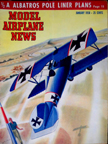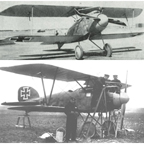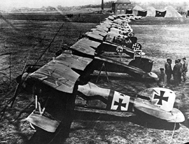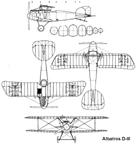January, 1950

Albatros D.III
Model Airplane News Cover Art for January, 1950
by Jo Kotula
Click to Enlarge
The Albatros D.III was a biplane fighter aircraft used by the Imperial German Army Air Service (Luftstreitkräfte "Airborne Force") and the Austro-Hungarian Air Service ("Luftfahrtruppen" - "Airborne Troops) during World War I. The D.III was flown by many top German aces, including Manfred von Richthofen and Ernst Udet. It was the preeminent fighter during the period of German aerial dominance known as "Bloody April" 1917.



Albatros D.III
Click to Enlarge
Work on the prototype D.III started in August 1916. Following on the successful Albatros D.I and D.II series, the D.III utilized the same semi-monocoque, plywood-skinned fuselage. At the request of the Idflieg ("Inspectorate of Flying Troops"). The D.III adopted a sesquiplane wing arrangement broadly similar to the French Nieuport 11. The upper wing was extended while the lower wing was redesigned with reduced chord and a single main spar. "V" shaped interplane struts replaced the previous parallel struts. For this reason, British aircrews commonly referred to the D.III as the "V-strutter."
After a Typenprüfung (official "type test") on 26 September 1916, Albatros received an order for 400 D.III aircraft, the largest German production contract to date. Idflieg placed additional orders for 50 aircraft in February and March 1917. The D.III entered squadron service in December 1916, and was immediately acclaimed by German aircrews for its maneuverability and rate of climb. But the lower wing had a propensity to fail; while the it had sufficient strength in static tests, it was subsequently determined that the main spar was located too far aft, causing the wing to twist under aerodynamic loads. Pilots were therefore advised not to perform steep or prolonged dives in the D.III. This design flaw persisted despite attempts to rectify the problem. Apart from its structural deficiencies, the D.III was considered pleasant and easy to fly, if somewhat heavy on the controls. The sesquiplane arrangement offered improved climb,maneuverability, and downward visibility but it was prone to spinning. Peak service was in November 1917, with 446 aircraft on the Western Front. 54 D.III aircraft remained on the Western Front.
Here is a video of the Albatros D.III in action:
Click Here for more information about the Albatros D.III.

Click to go back and select another cover.
Counter for the Entire Site (not just this page..)
Home | About Lindy | Last Week's Reviews | Upcoming Events | 1940s Collecibles
The Guide - Establishments - Travel - Accessories
Music | Links | Photo Gallery | Extras | Contact